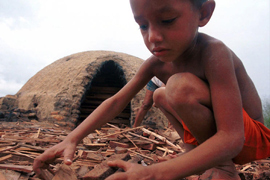Children face workplace abuse
Verbal and physical abuse is a terrifying fact of daily life for millions of child labourers.

In some regions the majority of them encountered some form of violence or abuse.
Unicef has identified that an estimated 171 million children, 73 million of whom are under 10 years old, work under hazardous situations or conditions, including work with chemicals and pesticides in agriculture, with dangerous machinery or in mines.
|
“… it is necessary to transform the mindset of societies and the underlying social and economic conditions of violence” Professor Paulo Sérgio Pinheiro, Interamerican Commission on Human Rights |
The UN agency, which has supported child development for over 60 years, estimates that 8.4 million children are forced into debt bondage or other forms of slavery, prostitution, pornography, armed conflict or other illicit activities.
ILO researchers found that apart from verbal and physical abuse, they often faced “casual violence, including sexual harassment, and in extreme cases even rape or murder”.
Some groups of child and adolescent workers were especially at risk, it said, such as domestic employees, young people working in the informal economy, modern forms of slavery, and those doing dangerous work.
Child violence in Latin America
A ‘Study on Violence against Children’ in Latin America and the Caribbean has also been launched to show that violence, which includes physical, sexual and psychological violence, discrimination and abandonment, remains hidden and is occasionally socially sanctioned.
The report, conducted by professor Paulo Sérgio Pinheiro, an independent expert appointed by Kofi Annan, the UN secretary general, shows that violence transcends cultural borders, class differences, education, ethnic origin or age.
The investigation shows that social and health consequences associated with violence represent an annual cost of approximately $145 billion, or 12 per cent of GDP, to the countries of Latin America and the Caribbean.
 |
|
A boy gathers wood for a furnace in Brazil |
“All countries can and must put an end to violence against children. This doesn’t mean being limited to punishing the aggressors, but it is necessary to transform the mindset of societies and the underlying social and economic conditions of violence,” said professor Pinheiro.
Extreme economic and social inequalities, the predominant culture of “machismo” which characterises the region, as well as to the failure to implement existing legal protection mechanisms, are blamed for contributing to violence against children, by the study.
The report highlighted that tolerance of violence against children only serves to favour the impunity of aggressors and reinforces the lack of political commitment to put an end to these grave human rights violations.
UN Universal Children’s Day
The UN secretary-general’s wider study on violence against children has been a global effort to paint a detailed picture of the nature, extent and causes of violence against children.
The study underlines and investigates factors that contribute to violence against children in the workplace, such as the characteristics of the victim, perpetrator, and the working environment.
While there is experience in dealing with abuse and violence within many existing programmes related to child labour, the international study reveals that most of them are “multi-pronged, addressing economic and cultural causes…[and] should be better researched and given more attention”.
In 1954, the UN general assembly recommended that all countries institute a Universal Children’s Day to be observed as a day of worldwide fraternity and understanding between children.
The date, November 20, marks the day on which the Assembly adopted the Declaration of the Rights of the Child, in 1959, and the Convention on the Rights of the Child, in 1989.